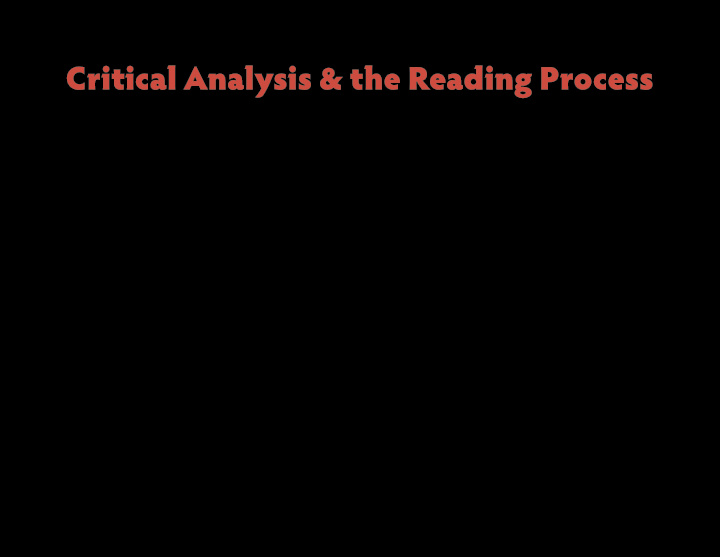



Critical Analysis & the Reading Process revised: 07.21.12 || English 1302: Composition II || D. Glen Smith, instructor
Guidelines for Reading Elements Which Enhance Developments of Stories: } 1. characters’ actions 2. characters’ intentions 3. plot rhythms— combination of protagonist’s journey, fmow of information and literary modes 4. story structure— also referred to as Freytag’s Pyramid 5. points of view— or Narrative Voice • Always be aware of these elements within every story we read in the course. revised: 07.21.12 || English 1302: Composition II || D. Glen Smith, instructor 2
Guidelines for Reading You should read the material three times. revised: 07.21.12 || English 1302: Composition II || D. Glen Smith, instructor 3
Guidelines for Reading You should read the material three times. • Before writing an academic paper, it is important to read the chosen material more than just once. revised: 07.21.12 || English 1302: Composition II || D. Glen Smith, instructor 4
Guidelines for Reading-First Reading The fjrst reading acts on an emotional level. • Concentrate on the actions of characters and the basic plot. • Try to enjoy the material as much as possible. I. Read fjrst for enjoyment, without interruption A. Notice the use of language and word play B. Consider the actions of the characters: • who is the protagonist and who is the antagonist? C. Note the setting and the atmosphere of the scene II. Afterwards, as soon as possible, determine the emotional impact A. Do you have any unanswered questions? B. Did you like the story? C. Did you relate to any of the characters? revised: 07.21.12 || English 1302: Composition II || D. Glen Smith, instructor 5
Guidelines for Reading-Second Reading The second reading acts on an analytical level. • Likewise, material you may have missed on the fjrst reading can be explored in greater detail. • Resolve unanswered questions. I . Concentrate on the plot details: A. To answer any possible questions B. To confjrm what you already know II. Determine: A. Journey theme: all protagonists go some form of journey B. Confmict type: all protagonists and antagonist have a confmicted relationship C. How do the elements affect the developments and actions of the characters? revised: 07.21.12 || English 1302: Composition II || D. Glen Smith, instructor 6
Guidelines for Reading-Third Reading The third reading specifjcally targets a higher level of critical analysis. • Since you can predict what will happen, you can analyze in closer details why characters act or react in the manner they do. • Newer insights can be gained regarding the author’s strategy and infmuences. I. It is important to be open to the entire work. A. consider how it relates to other readings B. discover what sets it apart from other writings II. Ask yourself what images and literary devices are used in the story. III. What is the author’s main goal for telling me this story? IV. Who do the characters resemble? V. Ask yourself: where have I seen this situation before? What inspirations or obvious emulations did the author use? revised: 07.21.12 || English 1302: Composition II || D. Glen Smith, instructor 7
Guidelines for Reading What is important about number fjve : • Literature grows out of other literature. No idea is absolutely original— nothing is original in the creative process ; borrowing from other established authors is frequent, consciously and subconsciously. intertextuality : the reinvention, insertion of situations and confmicts in a new sequence of thought to present a new idea; creation of something new out of an older concept. • With a third reading, it is easier to spot intertextuality. revised: 07.21.12 || English 1302: Composition II || D. Glen Smith, instructor 8
intertextuality The Top Four Literature which are referenced, reworked, reinvented : 1. Biblical stories 2. Shakespearean plays 3. Greek/Roman myths 4. Fairy tales Why do you think this is the case? What do these four types of writing share in common? Likewise, look for these emulations; they establish mood, atmosphere, scenery, and theme — consciously and subconsciously . revised: 07.21.12 || English 1302: Composition II || D. Glen Smith, instructor 9
Review of Reading Points • The fjrst reading acts on an emotional level. • The second reading acts on an analytical level. • The third reading targets a higher level of critical analysis. revised: 07.21.12 || English 1302: Composition II || D. Glen Smith, instructor 10
Literary Devices & Terminologies • plot: main course of action • setting: the landscape of the story • confmict: clash of opposing views, needs, actions • protagonist: main character; focal point of action • antagonist: a person the protagonist struggles against, or competes with; an adversary • climax: the ultimate scene of action; the decisive moment in a novel or play, results in the conclusion/resolution • subplots: minor secondary story lines behind the scene of main action revised: 07.21.12 || English 1302: Composition II || D. Glen Smith, instructor 11
Literary Devices & Terminologies • points of view: (voice/narration) thoughts and feelings which motivate story • irony: an event deliberately contrary to what the reader expects • foreshadowing: hints of a future development through elements of the story • motifs: reoccurring symbols which appear throughout the story • paradox: confmicting/contradictory statement • exposition: establishment of setting, prepares the fjctional world for reader • in medias res : latin: “in the middle of.” Many short stories use this technique. revised: 07.21.12 || English 1302: Composition II || D. Glen Smith, instructor 12
Recommend
More recommend